 CBA
Belgium Observatory
CBA
Belgium ObservatorySDSSp J173008.38+624754.7 is a new SU UMa type dwarf nova !
 CBA
Belgium Observatory
CBA
Belgium Observatory
SDSSp J173008.38+624754.7 is a new SU UMa type dwarf nova !
| SDSSp J173008.38+624754.7, located at RA =
17h30m08.38s,
Dec = +62°47'54.7" (J2000.0) is a recently discovered SDSS
dwarf nova (Szkody et al., astro-ph/0110291), identified with a strong
ROSAT source 1RXS_J173008.0+624744.
The object was detected in outburst by Timo Kinunnen on 2001,
October 18.765 UT at mag. 14.7 and rose to mag. 13.5 on October 20.785 UT
(vsnet-campaign-dn 1755). |
||
I made a first attempt to do unfiltered time-series CCD photometry on this object on October 19/20, 2001, using the 0.35-m f/6.3 telescope at CBA Belgium Observatory. Unfortunately, the session had to be ended after 1.1 hours, due to clouds entering the sky. The resulting light curve already showed clear signs of a modulation (see figure at right). |
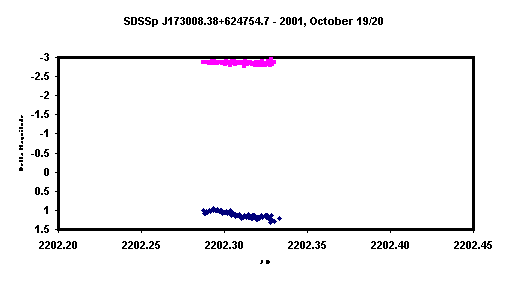 |
|
| October 22/23 was clear again, and allowed another unfiltered CCD session of SDSSp J173008.38+624754.7. I could observe the variable for 5.2 hours, under very good sky conditions. The resulting light curve, shown at right, clearly shows a typical superhump signature, thus establishing SDSSp J173008.38+624754.7 as a new UGSU-type dwarf nova. |
 |
|
| The night of October 25/26, 2001 provided a next opportunity to monitor this variable, although conditions were far from perfect, with lots of clouds in the sky. The resulting light curve is shown at left. There's still an indication of a superhump modulation, but it definitely is less pronounced than during our previous session. | 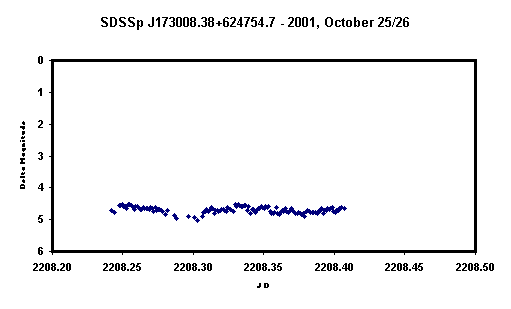 |
|
| October 26/27, 2001 gave a very short opportunity only to observe SDSSp J173008.38+624754.7, again using the 0.35-m f/6.3 telescope at CBA Belgium Observatory and an unfiltered SBIG ST-7 CCD. The light curve at right has an hint of (super?)hump modulation, but clearly is too short to derive any decent results. Let's hope it was clear at other observatories ! | 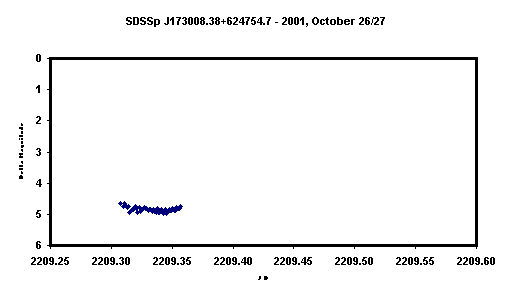 |
|
|
David Skillman, CBA East, contributed the observations shown in the two graphs at left. His first run was made on October 24/25, his second on October 26/27. Both were short sessions, but they nevertheless are important, because they clearly show that superhump activity was still ongoing in the system at the moment of the observations. |
|
|
| Using all of the available CBA Belgium and CBA East observations (961 observations), I performed at PDM analysis to determine the superhump period of SDSSp J173008.38+624754.7. The results are shown in the two graphs below. The left one is the period diagram. I derived a superhump period of 0.07941 +/- 0.00006 d. This value is in very close agreement with the findings of Makoto Uemura (VSNET collaboration team), published in vsnet-campaign-dn 1786. It however somewhat differs from a more recent value published by Uemura (vsnet-campaign-dn 1790), which might be due to a shortening of the superhump period in this system. The figure at right is the combined phase diagram. |
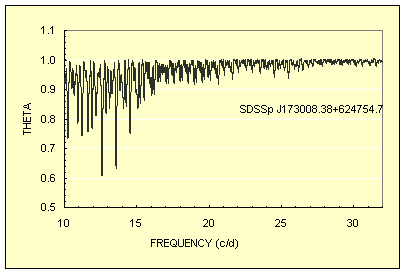 |
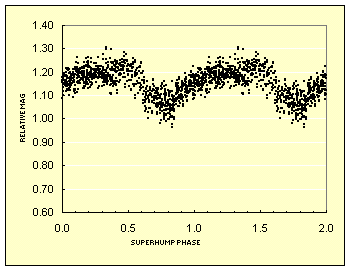 |
| SDSSp J173008.38+624754.7 period analysis | SDSSp J173008.38+624754.7 phase diagram |
| After having announced the results of the superhump period
analysis, based on the observations listed above, I managed to collect 1
additional night of data on SDSSp J173008.38+624754.7. That was on October
28/29 (see diagram at right). I also received a data set from David
Skillmann, CBA East, of that same night (see diagram below).
Adding all available data together (1123 datapoints), I made another analysis of the superhump period, and found an improved value of 0.07933 +/- 0.00004 d.
|
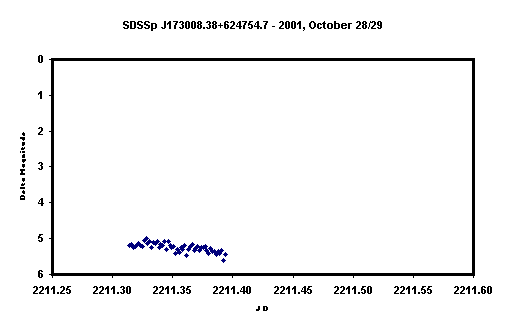 |
|
| This value very well fits the results of the VSNET Collaboration team, as announced by Taichi Kato in [vsnet-superoutburst 1121]. There, a value of 0.079294 +/- 0.000034 d is given. It seems we have a fairly accurately established the superhump period now. |
|
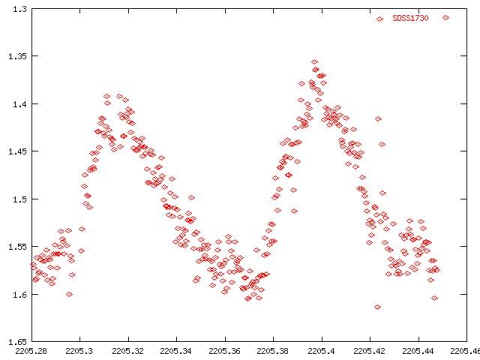
|
Arto Oksanen, Nyrola Observatory, Finland, independently also detected the UGSU nature of the object, based on observations obtained during the night of October 22/23, 2001. His dataset is reproduced at left. |